Effect of Water Injection on Turbine Inlet under Different Flight Conditions
Abstract
1. Introduction
2. Inlet Model and Numerical Method
2.1. TBCC Turbine Inlet Model
2.2. Numerical Method
2.3. Boundary Conditions
3. Grid Independence and Numerical Model Validation
4. Results and Discussions
4.1. Influence of Inlet Length on Evaporation Characteristics
4.2. Influence of WAR and Mach Number on Evaporation Characteristics
4.3. The Performance of WIPCC Engine
5. Conclusions
- (1)
- It is the first time that the mass injection field of turbine inlet of the TBCC engine was simulated. The air can be cooled by 167.5 K with WAR = 0.09, and the water droplets can evaporate by 93% at most. The effect of water-pre-cooling in the TBCC turbine inlet is proportional to the injected water mass when the flight speed is slower than Ma2.8, more water will not strengthen the pre-cooling effect even if the WAR exceeds 0.05. This is because that the air becomes saturated. However, a higher flight Mach number can improve the saturation point. Prolonging the inlet length is a feasible approach to enhancing the pre-cooling effect if the evaporation ratio is low.
- (2)
- The interaction between the cooled temperature and WAR at different flight Mach numbers was revealed. The range of the pre-cooled temperature by water injection is obtained, which reveals the requirements of the water mass flow and inlet channel length under a certain temperature limitation of the compressor. Water injection must be performed when the flight Mach number exceeds Ma2.3. The highest working speed of the turbine engine can be extended to Ma2.6 with WAR = 0.03. When the mass flow of the water climbs to WAR = 0.09, the working speed spectrum of the turbine engine can be extended to Ma3.0, and the temperature of the air remains lower than 470 K under this condition.
- (3)
- Water injection not only extends the working speed spectrum of the conventional turbine engine, but also improves the engine thrust and specific impulse. The thrust can be augmented to nearly 1.0 times the characteristic thrust at Ma3.0 with WAR = 0.09, which meets the thrust requirement of mode transition of the TBCC engine. However, mass injection reduces the specific impulse of the turbine engine, especially at high flight Mach numbers. Therefore, it is recommended that the WIPCC engine work at a high speed for a long time, because it will consume much water.
- (4)
- The simulation results of the study contribute to the inlet design of the TBCC engine. Due to the fact that the physics model of the inlet is a practical model, it is beneficial engineering applications. The evaluation provides a mass injection strategy for the MIPCC engine, which can promote the advancement of the engine design.
Author Contributions
Funding
Data Availability Statement
Conflicts of Interest
Nomenclature
| TBCC | Turbine-Based Combined Cycle |
| SLS | Sea Level Static |
| LOX | Liquid Oxygen |
| MIPCC | Mass Injection Pre-Compressor Cooling |
| WIPCC | Water Injection Pre-Compressor Cooling |
| WAR | Water-to-Air Ratio |
| MSTO | Multi-Stage-to-Orbit |
References
- Balepin, V. Method and Apparatus for Reducing the Temperature of Air Entering a Compressor of a Turbojet Engine by Variably Injecting Fluid into the Incoming Air. U.S. Patent 6,202,404, 20 March 2001. [Google Scholar]
- Mehta, U.; Bowles, J.; Melton, J. Water injection pre-compressor cooling assist space access. Aeronaut. J. 2015, 119, 145–171. [Google Scholar] [CrossRef]
- Xu, C.C.; Cho, H. Effect of methanol/water mixed fuel compound injection on engine combustion and emissions. Energies 2021, 14, 4491. [Google Scholar] [CrossRef]
- Balepin, V.; Bruno, C.; Ingenito, A. Evaluation of the combustion process in the mass injection precompression cooling engine. In Proceedings of the International Symposium on Air Breathing Engines, ISABE-2003-1127, Renaissance Cleveland Hotel, Cleveland, OH, USA, 31 August–5 September 2003. [Google Scholar]
- Kim, K.H.; Perez, B.H. An Assessment of High-Fogging Potential for Enhanced Compressor Performance. In Proceedings of the Turbo Expo: Power for Land, Sea, and Air, GT 2006-90482, Barcelona, Spain, 8–11 May 2006. [Google Scholar]
- Balepin, V.; Engers, R.; Terry, S. MIPCC technology development. ISABE-2005-1297. In Proceedings of the 12th AIAA International Space Planes and Hypersonic Systems and Technologies, Norfolk, Virginia, 15–19 December 2003. [Google Scholar]
- Cater, P.H.; Balepin, V. Mass injection and pre-compressor cooling engines analyses. In Proceedings of the 38th AIAA/ASME/SAE/ASEE Joint Propulsion Conference & Exhibit, AIAA-2002-4127, Indianapolis, IN, USA, 7–10 July 2002. [Google Scholar]
- Balepin, V.; Liston, G.W. The Steamjet: Mach 6+ turbine engine with inlet air conditioning. In Proceedings of the 37th Joint Propulsion Conference and Exhibit, AIAA-2001-3238, Salt Lake City, UT, USA, 8–11 July 2011. [Google Scholar]
- Lopata, J.; Carter, P. DARPA’s RASCAL: Status, challenges, and accomplishments. In Proceedings of the 18th Annual AIAA/USU Conference on Small Satellites, AIAA-SSC04-X-2, Logan, UT, USA, 9–12 August 2004. [Google Scholar]
- Carter, P.; Brown, O.; Rice, T.; Tardy, J. RASCAL: DARPA’s solution to responsive, affordable, micro-satellite space access. In Proceedings of the 17th Annual AIAA/USU Conference on Small Satellites, AIAA-SSC03-I-1, Logan, UT, USA, 11–14 August 2003. [Google Scholar]
- Young, D.A.; Olds, J.R. Responsive Access Small Cargo Affordable Launch (RASCAL) independent performance evaluation. In Proceedings of the AIAA/CIRA 13th International Space Planes and Hypersonics Systems and Technologies Conference, AIAA-2005-3241, Capua, Italy, 16–20 May 2005. [Google Scholar]
- Kloesel, K.; Clark, C. Preliminary MIPCC-Enhanced F-4 and F-15 performance characteristics for a first stage reusable launch vehicle. In Proceedings of the AIAA Space 2013 Conference and Exposition, AIAA-2013-5528, San Diego, CA, USA, 10–12 September 2013. [Google Scholar]
- Liang, Z.X.; Chen, Y.C.; Huang, X.L. Performance simulation of Steamjet with afterburner. J. Aerosp. Power 2010, 25, 1316–1321. [Google Scholar]
- Tu, H.Y.; Deng, Y.H.; Kang, S. Numerical simulation for effects for water/air ratio on injection characteristics with water injection pre-compressor cooling. J. Propuls. Technol. 2017, 38, 1302–1309. [Google Scholar]
- Liu, X.F.; Chang, H.W.; Xue, H.K. Investigation on temperature drop and flow resistance characteristics of mass injection pre-compressor cooling device. Aeroengine 2018, 44, 81–86. [Google Scholar]
- Lin, A.; Zhou, J.; Fawzy, H.; Zhang, H.; Zheng, Q. Evaluation of mass injection cooling on flow and heat transfer characteristics for high-temperature inlet air in a MIPCC engine. Int. J. Heat Mass Transf. 2019, 135, 620–630. [Google Scholar] [CrossRef]
- Lin, A.; Zheng, Q.; Jiang, Y.; Lin, X.; Zhang, H. Sensitivity of air/mist non-equilibrium phase transition cooling to transient characteristics in a compressor of gas turbine. Int. J. Heat Mass Transf. 2019, 137, 882–894. [Google Scholar] [CrossRef]
- Lin, A.; Zheng, Q.; Fawzy, H.; Luo, M.; Zhou, J.; Zhang, H. Effect of water injection cooling on flow field characteristics in the cooling section of precooled turbine-based combined cycle engine. Int. J. Heat Mass Transf. 2019, 141, 615–626. [Google Scholar] [CrossRef]
- Lin, A.; Liu, G.; Chen, Y.; Feng, Q.; Zhang, H. Evaluation and analysis of evaporation cooling on thermodynamic and pressure characteristics of intake air in a precooled turbine engine. Int. J. Hydrog. Energy 2021, 46, 24410–24424. [Google Scholar] [CrossRef]
- Lv, C.; Xu, H.; Quan, F.; Chang, J.; Yu, D. Thermodynamic modeling and analysis of ammonia injection pre-compressor cooling cycle: A novel scheme for high Mach number turbine engines. Energy Convers. Manag. 2022, 265, 115776. [Google Scholar] [CrossRef]
- Lv, C.; Xu, H.; Chang, J.; Wang, Y.; Chen, R.; Yu, D. Mode transition analysis of a turbine-based combined-cycle considering ammonia injection pre-compressor cooling and variable-geometry ram-combustor. Energy 2022, 261, 125324. [Google Scholar] [CrossRef]
- Mattingly, J.D.; Heiser, W.H.; Pratt, D.T. Aircraft Engine Design; AIAA Education Series; AIAA: Reston, VA, USA, 2002. [Google Scholar]
- Hill, P.G. Aerodynamic and thermodynamic effects of coolant injection on axial compressors. Aeronaut. Q. 1963, 14, 331–348. [Google Scholar] [CrossRef]




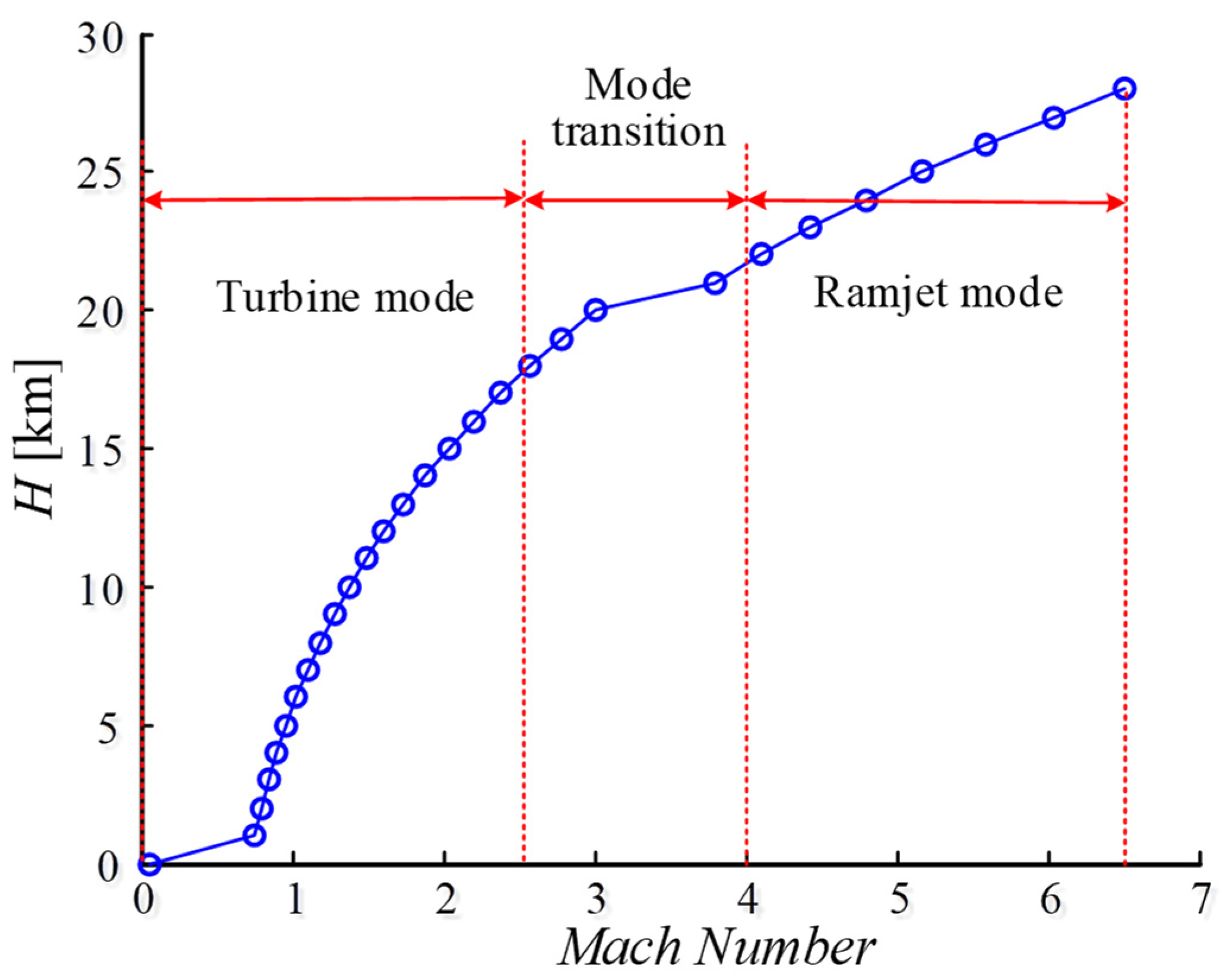
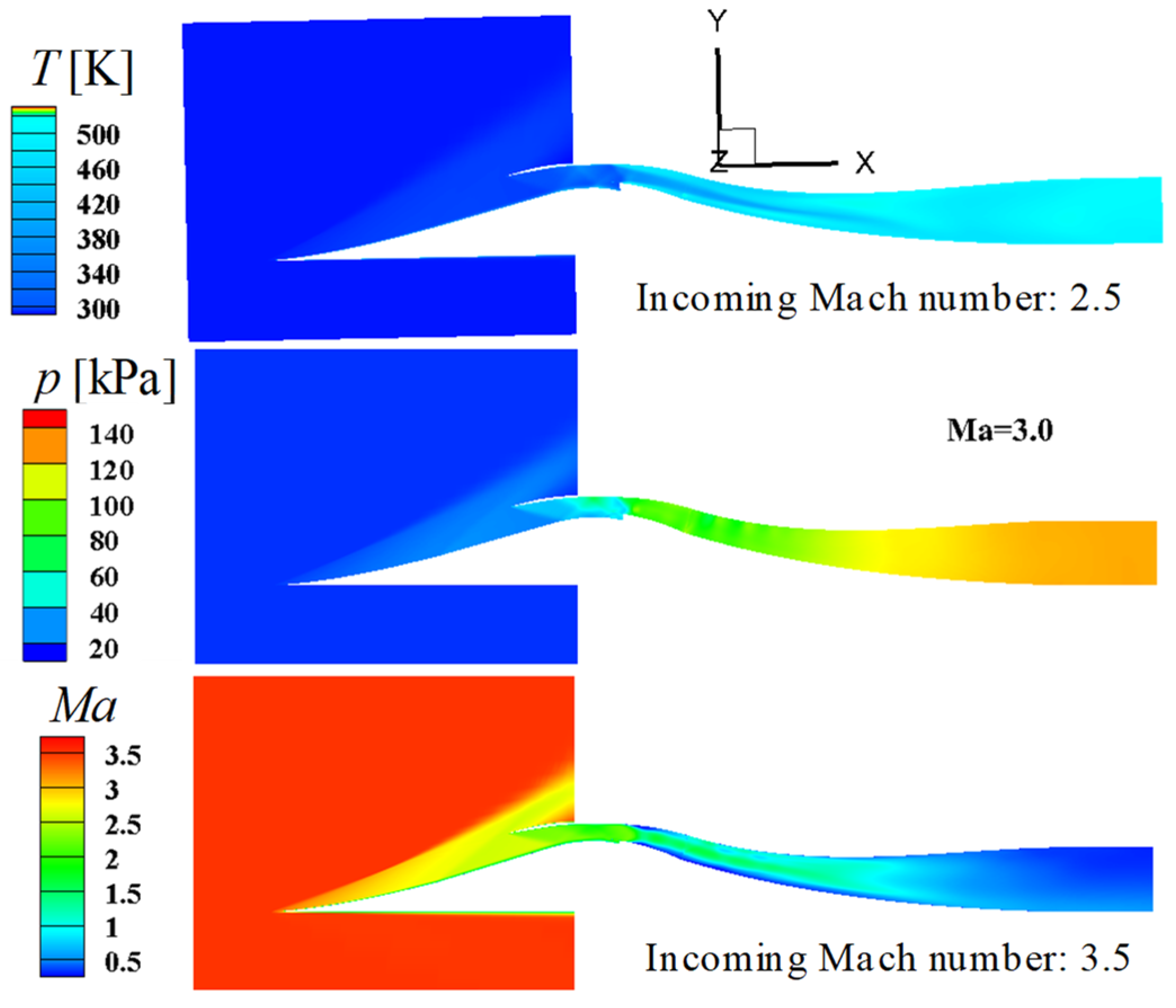
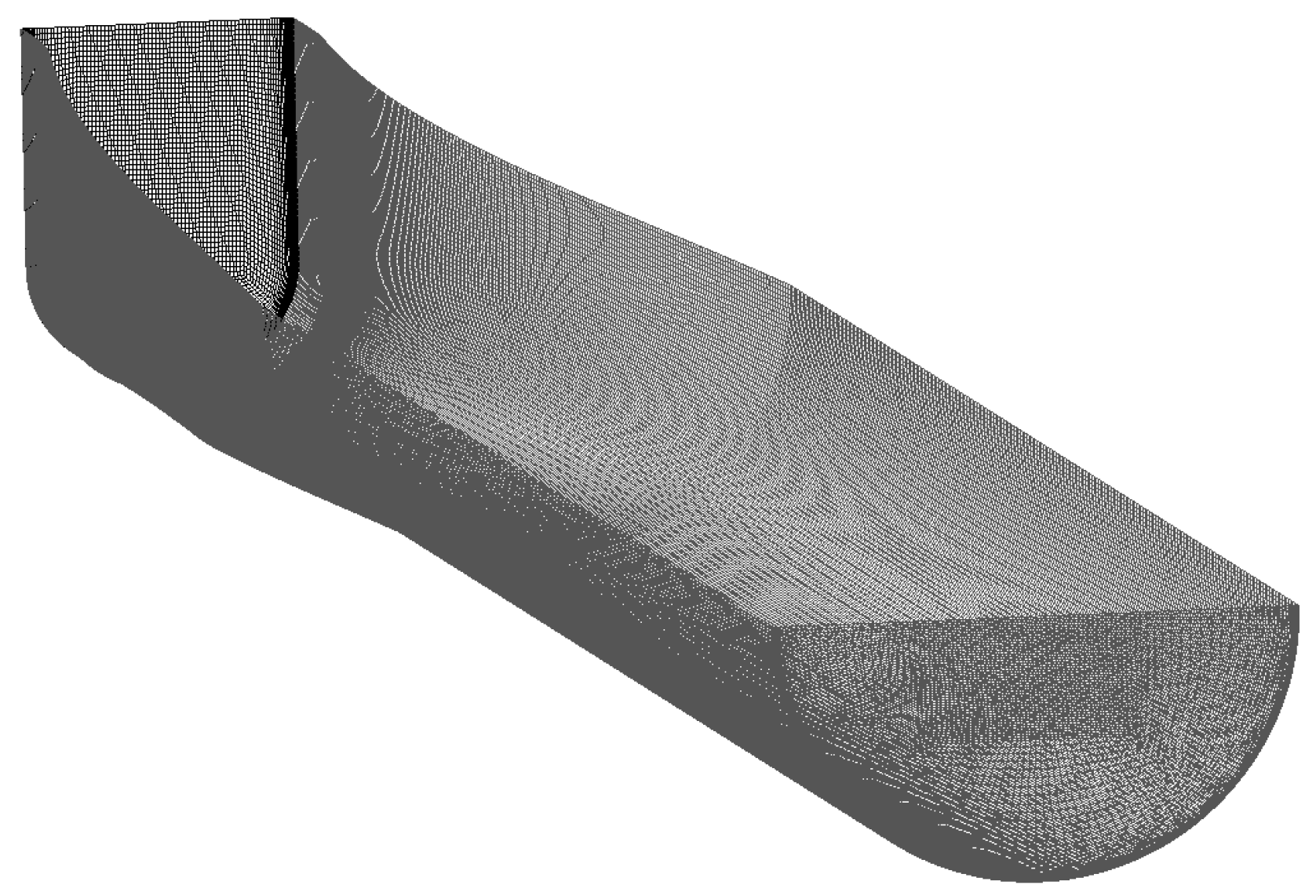

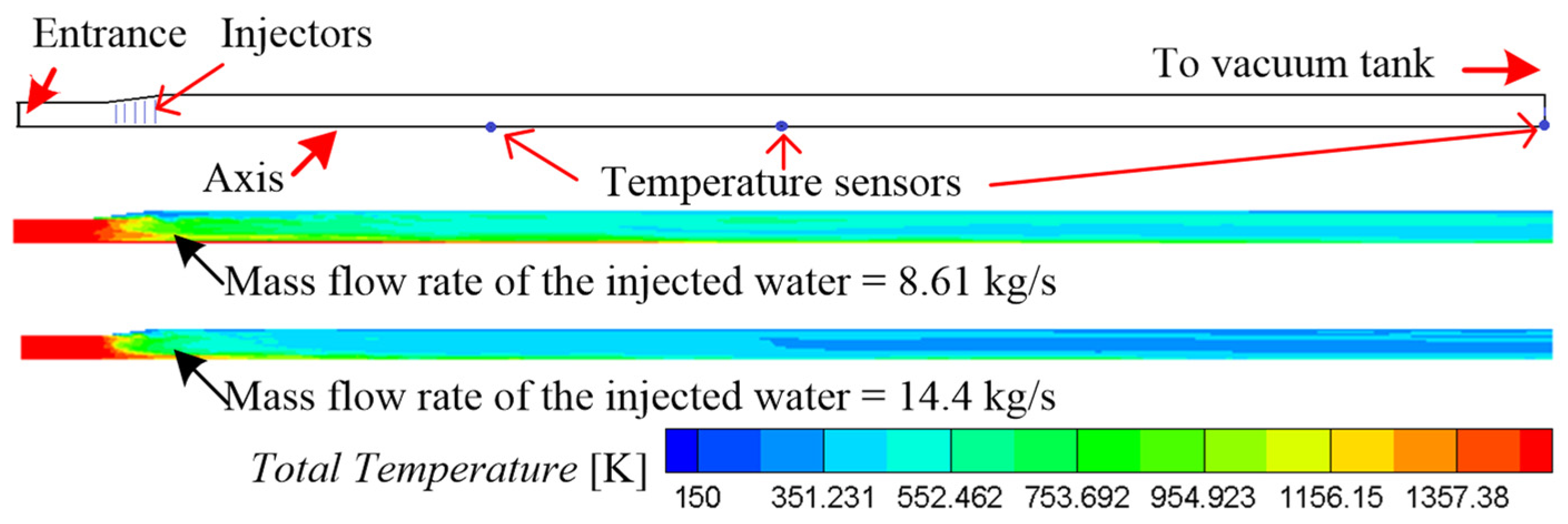
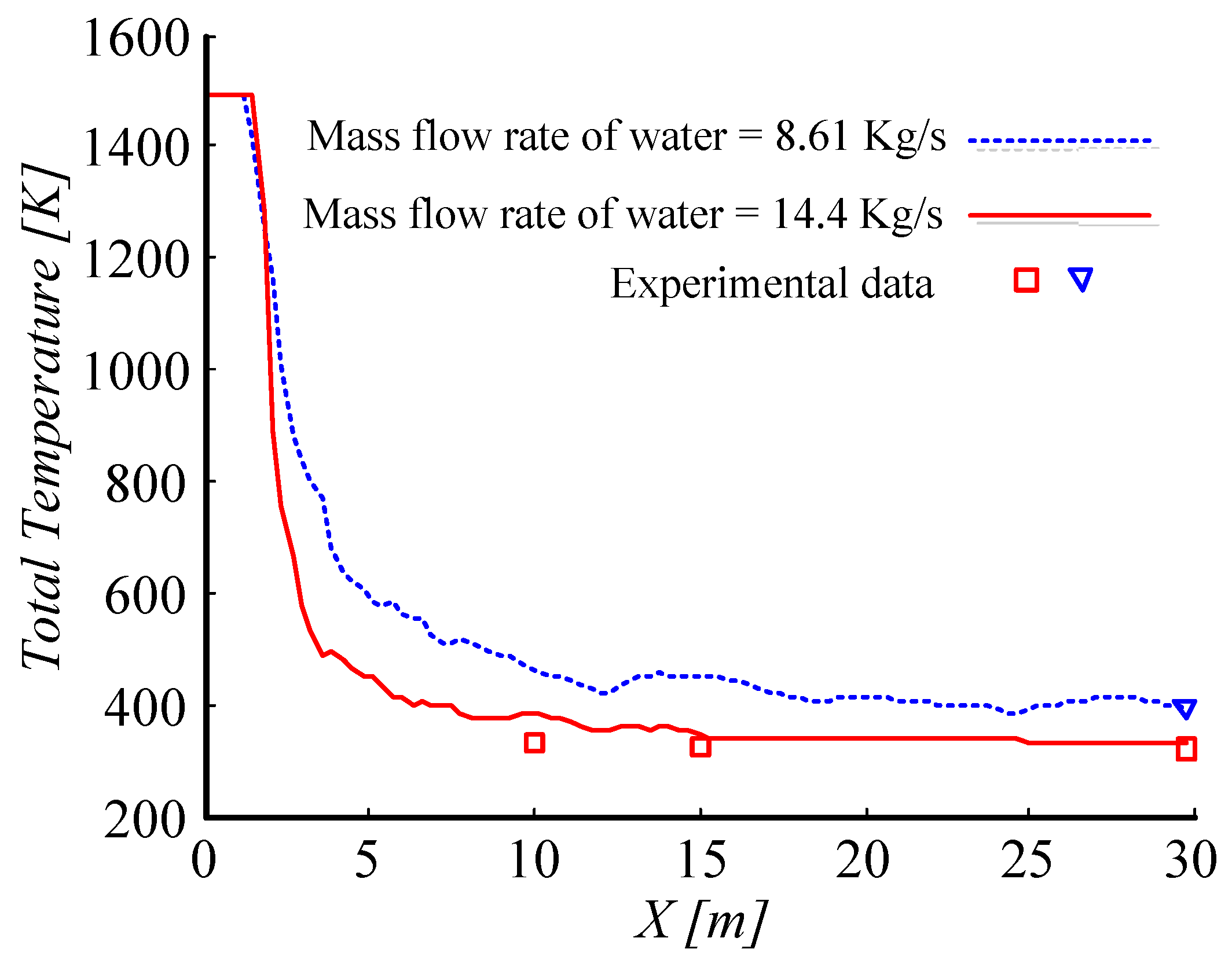







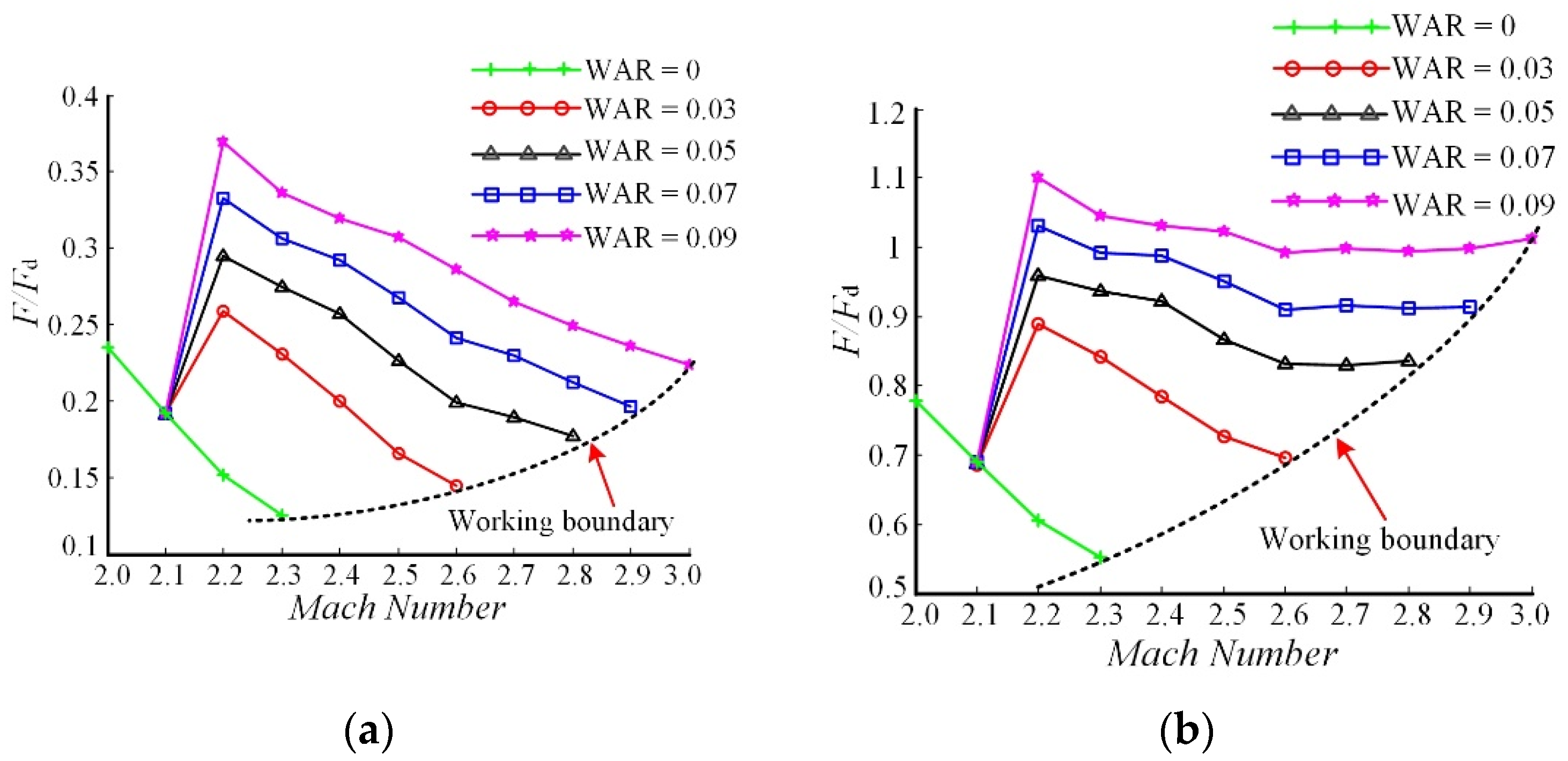
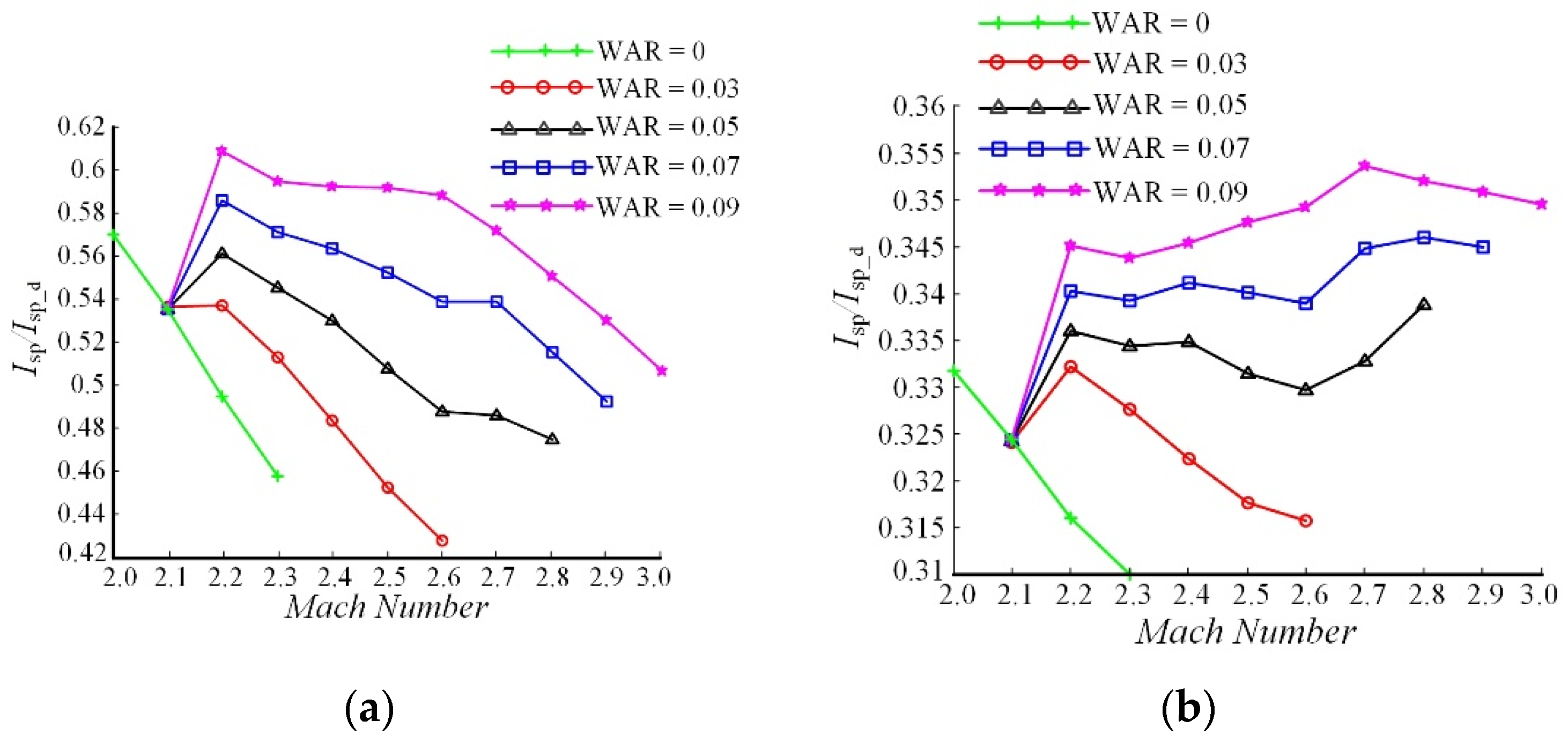
| Flight Mach Number | Cross-Section at Water Injection | Inlet Channel Exit | ||
|---|---|---|---|---|
| Static Pressure (kPa) | Total Temperature (K) | Incoming Mach Number | Static Pressure (kPa) | |
| Ma2.2 | 98.2 | 426.2 | 0.541 | 109.1 |
| Ma2.4 | 100.0 | 466.4 | 0.559 | 112.5 |
| Ma2.6 | 104.7 | 509.5 | 0.5962 | 119.1 |
| Ma2.8 | 109.4 | 556.2 | 0.6326 | 128.8 |
| Ma3.0 | 113.8 | 606.5 | 0.669 | 132.5 |
| Ma3.2 | 119.3 | 662.7 | 0.710 | 141.4 |
Publisher’s Note: MDPI stays neutral with regard to jurisdictional claims in published maps and institutional affiliations. |
© 2022 by the authors. Licensee MDPI, Basel, Switzerland. This article is an open access article distributed under the terms and conditions of the Creative Commons Attribution (CC BY) license (https://creativecommons.org/licenses/by/4.0/).
Share and Cite
Luo, J.; Huang, S.; Yang, S.; Zhang, W.; Mu, Z. Effect of Water Injection on Turbine Inlet under Different Flight Conditions. Energies 2022, 15, 7447. https://doi.org/10.3390/en15197447
Luo J, Huang S, Yang S, Zhang W, Mu Z. Effect of Water Injection on Turbine Inlet under Different Flight Conditions. Energies. 2022; 15(19):7447. https://doi.org/10.3390/en15197447
Chicago/Turabian StyleLuo, Jiamao, Shengfang Huang, Shunhua Yang, Wanzhou Zhang, and Zhongqiang Mu. 2022. "Effect of Water Injection on Turbine Inlet under Different Flight Conditions" Energies 15, no. 19: 7447. https://doi.org/10.3390/en15197447
APA StyleLuo, J., Huang, S., Yang, S., Zhang, W., & Mu, Z. (2022). Effect of Water Injection on Turbine Inlet under Different Flight Conditions. Energies, 15(19), 7447. https://doi.org/10.3390/en15197447







